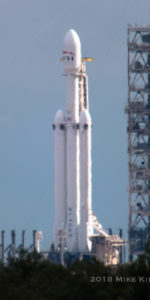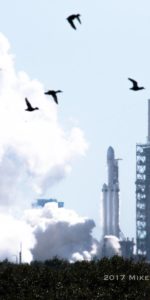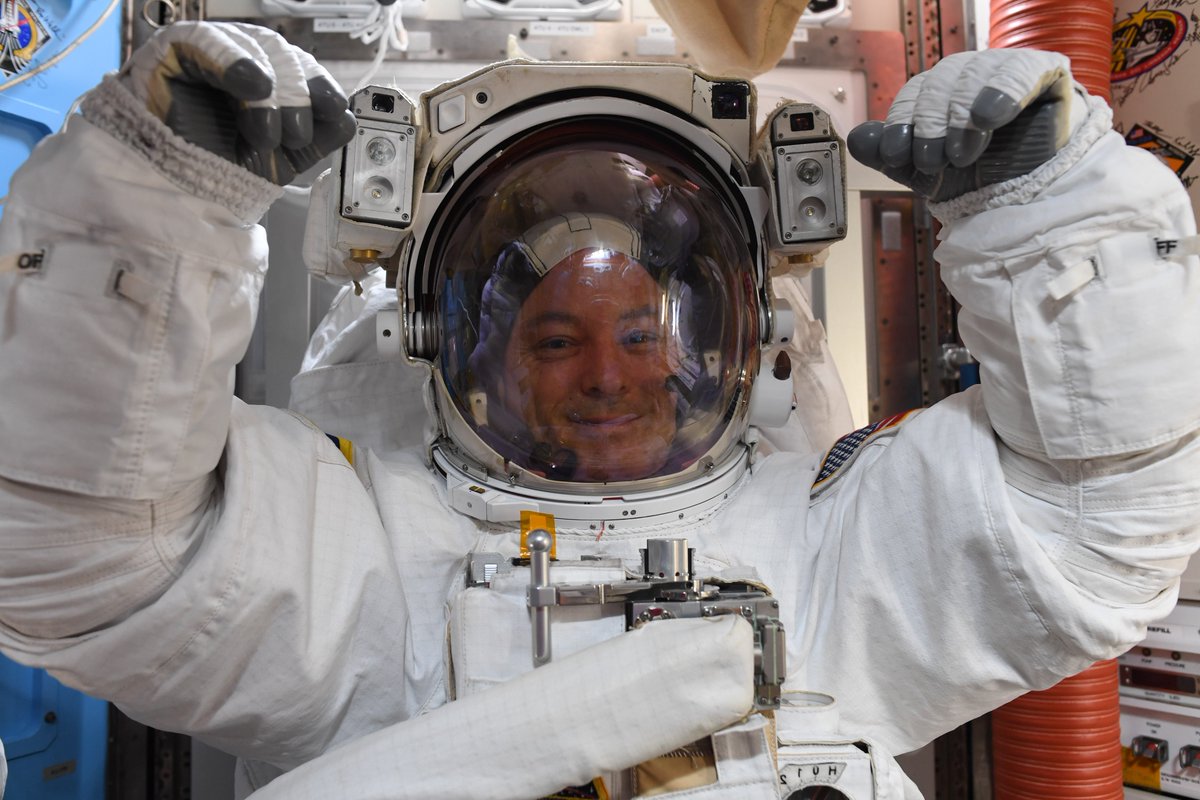
A pair of fiftysomething fathers labored for seven hours and 24 minutes earlier today (Tuesday, 23 January) on an ambitious spacewalk to replace the second of two degraded Latching End Effectors (LEE-B) on the 57.7-foot-long (17.6-meter) Canadarm2 robotic arm aboard the International Space Station (ISS). Six weeks after the most recent Army-Navy Game ended in the Black Knights’ favor, Army Col. Mark Vande Hei and Navy Capt. Scott Tingle worked at External Stowage Platform (ESP)-2, close to the station’s Quest airlock, to perform their intricate task on the long-serving arm. Assisting them from inside the space station were fellow Expedition 54 crewmen Joe Acaba and Norishige Kanai. Next week, Vande Hei and Kanai will venture outside to complete the work and bring the degraded LEE-A back into the station for return to Earth.
Since its installation by the STS-100 shuttle crew, way back in April 2001, Canadarm2 has been an invaluable asset to the ISS. Over 17 years, it has played a critical role in the construction and maintenance of the multi-national outpost, as well as capturing and deploying 27 unpiloted cargo ships, from the capture of Japan’s first H-II Transfer Vehicle (HTV) in September 2009 to the unberthing of SpaceX’s CRS-13 Dragon, earlier this month. And in the words of Canadian Space Agency (CSA) liaison Tim Braithwaite, speaking at last week’s press conference at the Johnson Space Center (JSC) in Houston, Texas, the arm is highly serviceable. “Every part of the arm, from one end to the other,” explained Mr. Braithwaite, “is physically replaceable on-orbit, either by spacewalking astronauts or by our two-armed robot, Dextre.”
Unlike the Remote Manipulator System (RMS) of the now-retired Space Shuttle—whose behavior mimicked the human arm in several respects—Canadarm2 has “hands” at each end, enabling it to inchworm its way along the station’s expansive truss structure from worksite to worksite, plugging its Power and Data Grapple Fixtures (PDGFs) into receptacles along the way. These hands are known as Latching End Effectors (LEEs), distinguishable by the alphabetical designations “A” and “B”. Each LEE is a cylindrical device, about 3.5 feet (1.1 meters) long and weighing around 415 pounds (188.2 kg).
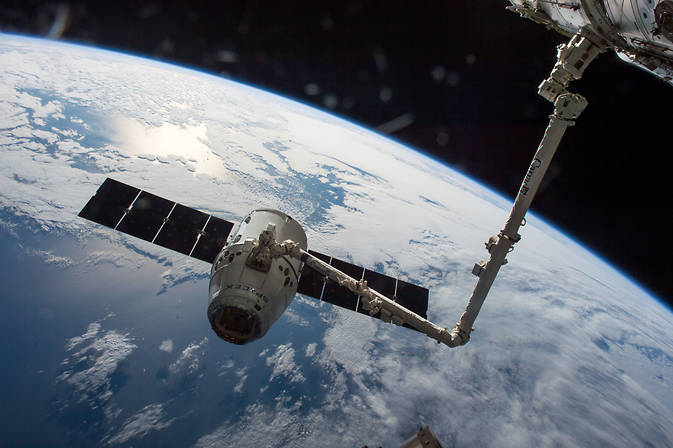
Originally designed for a lifespan of ten to 15 years, Canadarm2’s performance has been almost top-notch. During initial checkout in May-June 2001, it endured a spate of backup software glitches and in March 2002 a failure occurred in its wrist roll-joint, which triggered some LEE degradation. This joint was later replaced by spacewalkers on the STS-111 shuttle mission in June 2002. Since then, the arm has functioned well, although Mr. Braithwaite stressed that wear-and-tear has recently manifested itself through increasing motor current in its latches.
The LEEs were lubricated by spacewalkers during Expedition 42 in February 2015 and Expedition 50 in January of last year, which bought the program some time, but it was recognized that the replacement of both ends were necessary to restore Canadarm2 to full operational capacity. It was planned to replace LEE-B in October 2017, but during a “walkoff” operation of the arm last August, the LEE-A latches stalled, posing a more immediate risk to the system. It was decided that LEE-A would be replaced first—by Expedition 53 spacewalkers Randy Bresnik and Mark Vande Hei, last 5 October—and leave the LEE-B changeout until a subsequent excursion in early 2018. Although both ends of the arm look identical, LEE-B boasts a black stripe for distinction.
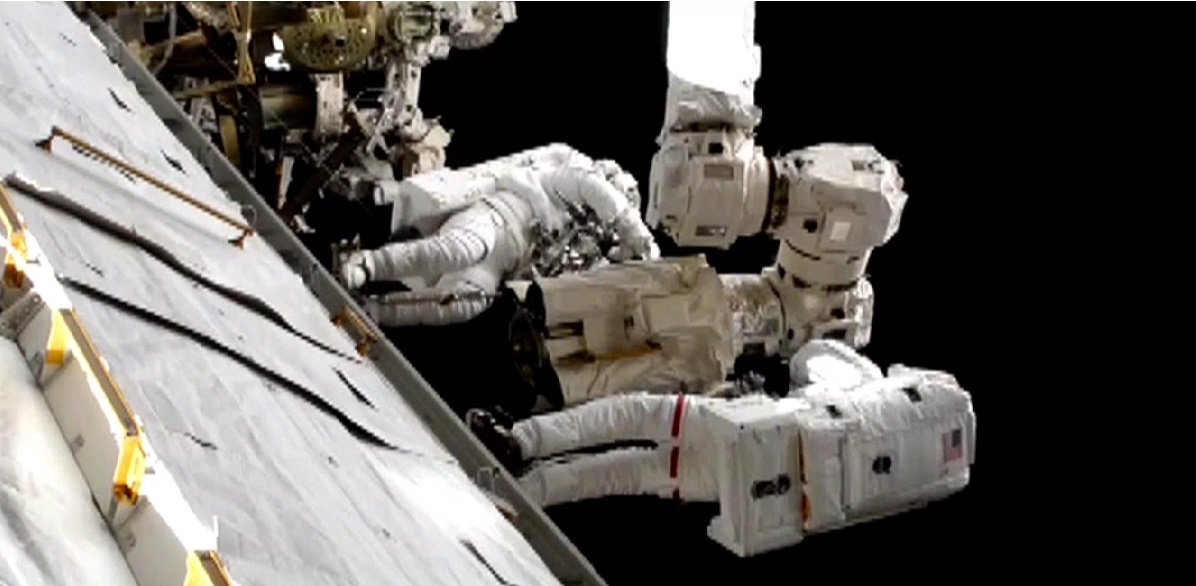
Over the New Year period, the four-man U.S. Orbital Segment (USOS) crew of Vande Hei, Tingle, Kanai and Joe Acaba worked to prepare the Extravehicular Mobility Units (EMUs) for their role in the upcoming spacewalks. For the opening excursion, Vande Hei would wear EMU #3003, which has an exceptional service history. First flown on shuttle mission STS-77 in May 1996, it saw its first actual use on STS-82, the second Hubble Space Telescope (HST) upgrade in February 1997. It was subsequently worn by Japan’s first spacewalker, Takao Doi, in November 1997 and by Susan Helms in March 2001 on what still stands as the longest single EVA ever performed. By contrast, Tingle would wear EMU #3004, recently delivered to the ISS aboard last month’s CRS-13 Dragon.
The crew set up equipment in the station’s Quest airlock and Vande Hei and Tingle undertook suited “fit-checks” over the last couple of weeks. On 17 January, they conducted scrubbing and iodination of the EMU and airlock cooling water loops, configured their tools and participated in training with the Dynamic On-board Ubiquitous Graphics (DOUG) software to review translation paths outside the station.
Early Tuesday, 23 January, the crew awoke early and took a quick breakfast, before pressing directly into EVA preparations. Assisting Vande Hei and Tingle in the airlock were Acaba and Kanai. The spacewalkers spent about 60 minutes “pre-breathing” on masks and Quest’s inner “equipment lock” was depressed from its ambient 14.7 psi to 10.2 psi, allowing for suit checks and purging. It was then repressed back up to 14.7 psi, enabling the astronauts to undertake a nominal pre-breathing regimen and 50 minutes of in-suit light exercise.
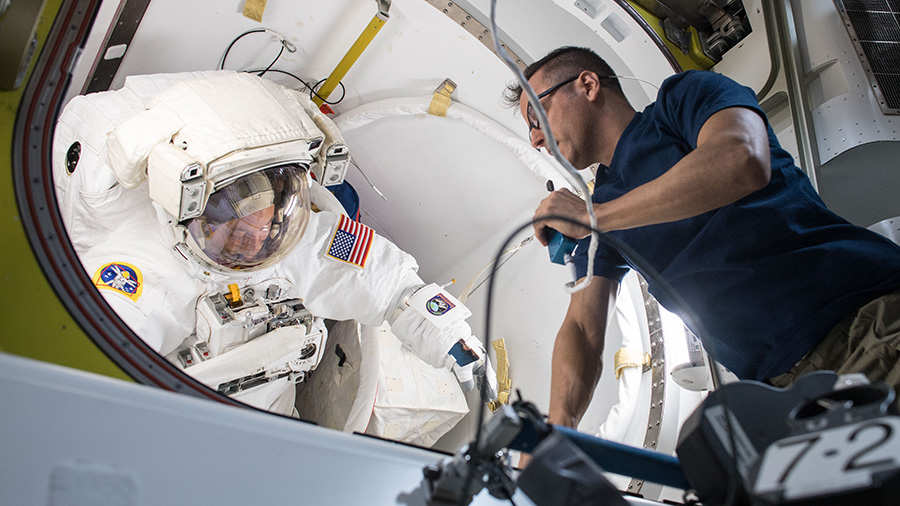
At length, Acaba and Kanai transferred the fully suited duo from the equipment lock into the outer “crew lock” and closed the connecting hatches. Depressurization of the crew lock commenced shortly afterwards and reached a condition of near-vacuum at 0.5 psi. Vande Hei and Tingle transferred their suits’ life-support utilities onto battery power and U.S. EVA-47—the 47th spacewalk in U.S.-built suits, conducted without the presence of the Space Shuttle—got underway at 6:49 a.m. Today’s activities were led by the Orbit-2 team in the Mission Control Center (MCC) at JSC, led by Flight Director Tony Ceccacci and astronauts Vic Glover and Aki Hoshide at the Capcom’s console.
Vande Hei, of course, has two previous EVAs to his credit, totaling 13 hours and 21 minutes, but Tingle was embarking on his first excursion and became the 222nd human since Alexei Leonov to perform a spacewalk. The two men performed “buddy checks” of each other’s suits, including gloves and Helmet Absorption Pads (HAPs), tethers and tools. They then headed to External Stowage Platform (ESP)-2, located on the port side of Quest, and ingressed a pair of Articulating Portable Foot Restraints (APFRs).
With old-hand Vande Hei leading as “EV1”, with red stripes on the legs of his suit, they set to work preparing the replacement LEE for installation. This unit had been delivered to the station aboard shuttle Atlantis on STS-129 in November 2009, affixed to the ExPRESS Logistics Carrier (ELC)-1, for emplacement on the port side of the truss, but was remotely maneuvered over to ESP-2 on the starboard side, close to the Quest airlock, last fall. “EVA time is a very valuable resource,” EVA-47 Flight Director Zeb Scoville told AmericaSpace Monday. “As such, last fall we robotically swapped the location of two pieces of spare hardware. This brought the spare LEE closer to the worksite and allowed us to complete these tasks in two EVAs, istead of three. Similarly, we have temporarily placed a nearby spare unit on [Dextre] to open up some space near the spare LEE. This gives more room for the crew to perform their tasks under ESP-2.”

Vande Hei and Tingle promptly set to work removing Multi-Layered Insulation (MLI) blankets to uncover the joint interface, as well as four launch-restraint clamps to release it from its Flight Support Equipment (FSE) pallet. Despite some difficulty with the clamps, all four were released by 8:30 a.m., a little under two hours into the EVA. This enabled the spare LEE to be pivoted upright. Meanwhile, at the controls of a Robotics Workstation (RWS) inside the station, Acaba and Kanai maneuvered Canadarm2 and positioned the LEE-B directly between Vande Hei and Tingle. The arm was then electrically powered-down at 9:40 a.m., allowing the spacewalkers to complete the removal of bolt-like Expandable Diameter Fasteners (EDFs) and detach LEE-B. The old end effector was freed from the robotic arm a few minutes before 10 a.m.
The duo temp-stowed the old LEE-B onto the FSE pallet “ring” and installed its replacement onto the end of Canadarm2, swapping out the Camera and Light Pan Tilt Assembly (CLPA) from the old end effector over to the new. The replacement LEE-B was in place by 12 noon, allowing Mission Control to power-up the arm a few minutes later for initial checkout. In spite of the need to briefly power down to tend to a software issue, the reactivation went without incident and by 1:20 p.m. Vande Hei and Tingle were in the process of cleaning up their worksite for return to the airlock. The 206th spacewalk devoted to ISS construction and maintenance ended at 2:13 p.m., after seven hours and 24 minutes.
Speaking last week, CSA’s Tim Braithwaite explained that the old LEE-B will be positioned on the Mobile Base System (MBS) on the truss during next week’s EVA-48 by Vande Hei and Kanai. It is expected to remain there through the end of the ISS Program, thus saving CSA the need to build another “spare” LEE. In the meantime, the old LEE-A—removed by Bresnik and Vande Hei, last October—will be brought inside the station at the end of EVA-48 for storage, possibly in the Bigelow Expandable Activity Module (BEAM). “We are proud to be working with @NASA to evaluate BEAM as a valuable storage facility on @Space_Station,” Bigelow Aerospace tweeted, “which could include the Latching End Effector being brought into station during NASA’s spacewalk today.” The old LEE-A is expected to be returned to Earth aboard a SpaceX Dragon for refurbishment as an operational flight spare.
Looking ahead, Canadarm2 has a full plate of duties ahead for 2018. Having already been used in early January for the departure of SpaceX’s CRS-13 Dragon, it is possible that the arm will support as many as six more unpiloted visiting vehicles. These include inbound SpaceX Dragons in April, June and November, Orbital ATK Cygnuses in May and November and Japan’s H-II Transfer Vehicle (HTV) in mid-August, equaling the number of “captures” by Canadarm2 in 2017.
FOLLOW AmericaSpace on Facebook!




